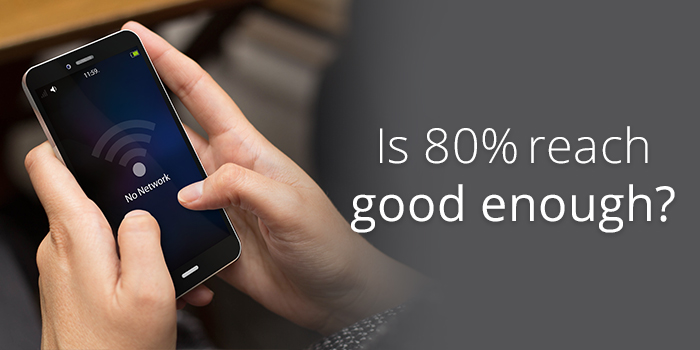Why Settling for Less Isn’t an Option
The emergency mass notification industry is primarily centered around sending bulk SMS text messages to mobile phones. Maybe your organization already uses this tool to send mass messages. It’s a necessary component of an emergency mass notification system, but by itself, it’s insufficient.1 Research done at Western Washington University shows that mobile notifications are only ~80 percent effective.2 That may sound ok, but what if you’re one of the 20 percent that didn’t receive an alert? What if that alert contained critical information about an active shooter or the need to take shelter from an approaching storm? Would your organization still think 80 percent was good enough?
Many factors contribute to preventing mobile notifications from reaching 100 percent of their intended audience. Some organizations don’t have everyone’s phone numbers in the system. Mobile phones are often on silent. Other times, the phone may be in a bag, briefcase, or otherwise out of sight. There are many circumstances when people must put away their phones, such as in healthcare institutions or classrooms. Sometimes it’s as simple a fact as being in a building with poor cellular coverage.
Combat Ineffective Messages with a Mobile Alert System with Mass Notification Capabilities
The key to achieving 100 percent reach is to supplement mobile alert system with additional communication methods, such as in-building notifications, specifically audio and visual broadcasts to existing overhead paging or public address systems, desktop alerts, digital signage, and desktop phones. Using multiple channels, i.e., in-building communications as well as mobile notifications, has the added benefit of increasing the sense of urgency perceived by the recipient.3
By combining in-building notification methods with a mobile alert system, your critical alerts will be received far faster and reach much closer to 100 percent of your desired population. Achieving the highest level of speed and reach should be the goal of any mass notification system.
Calling vs. Broadcasting
If you’re looking for more ways to increase the effectiveness of your emergency mass notifications, check out our blog post on the advantages of using an emergency notification system to broadcast to phones, rather than calling them, during a crisis.
Footnotes1 “If organizations want to instill a sense of urgency quickly, they must not simply rely on asynchronous channels—for example, text messaging—sent through their members’ personal mobile devices.” Organizational Communication in Emergencies: Using Multiple Channels and Sources to Combat Noise and Capture Attention: http://onlinelibrary.wiley.com/doi/10.1111/hcre.12002/full (Human Communication Research Vol. 39, Issue 2)
2 “88% of students had their cell phones turned on during class. 82% of students were registered with the school’s emergency system. 77% had cell phone service in most campus buildings.” Sattler, David & Larpenteur, Katy & Shipley, Gayle. (2011). Active Shooter on Campus: Evaluating Text and E-mail Warning Message Effectiveness. Journal of Homeland Security and Emergency Management. 8. 10.2202/1547-7355.1826.
3 “This research provides an example of how, even in an emergency, multiple communication approaches are important and indicate that individuals can more rapidly understand the urgency of a situation by incorporating synchronous channels.” Organizational Communication in Emergencies: Using Multiple Channels and Sources to Combat Noise and Capture Attention: http://onlinelibrary.wiley.com/doi/10.1111/hcre.12002/full (Human Communication Research Vol. 39, Issue 2)
